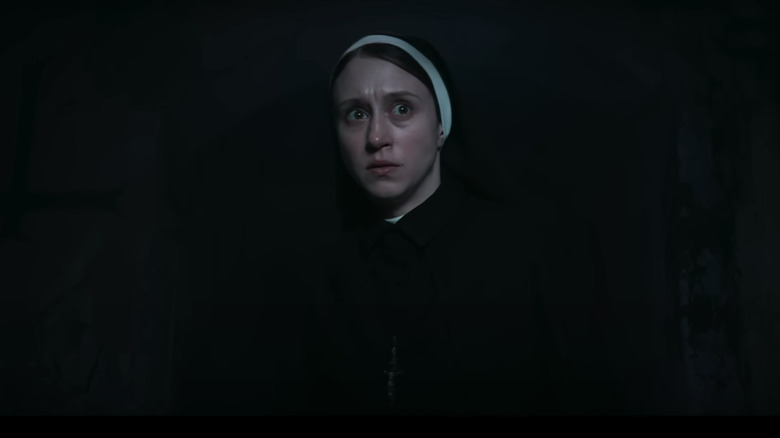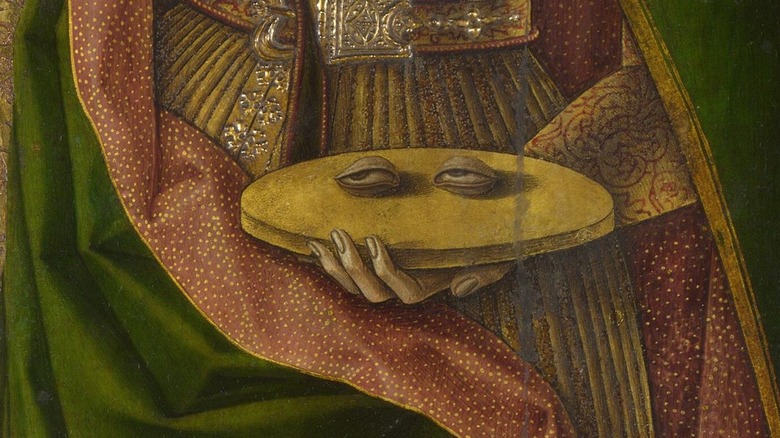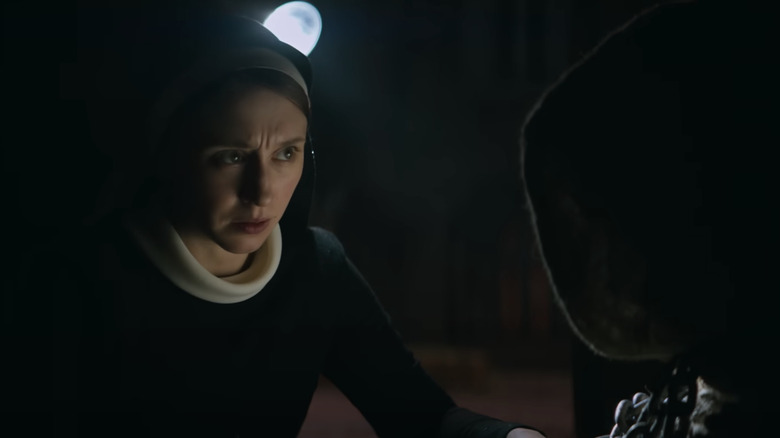The Grim True Story Behind Saint Lucy In The Nun 2
This article contains spoilers for "The Nun 2."
For the most part, the stories in The Conjuring Universe are remembered as ghosts and hauntings, despite the fact that demons and possessions are very much embedded in the DNA of "The Conjuring," "Annabelle," and "The Nun" films. Ghosts are typically waved away as being "not real" and the demon Valak of "The Nun" series is based on Valac, a demon described in the anonymous book on sorcery, "The Lesser Key of Solomon." Malthus, the demon responsible for the cursed Annabelle doll is based on Halphas, also depicted in "The Lesser Key of Solomon" as well as in Johann Weyer's "Pseudomonarchia Daemonum," which identifies 69 (nice) demons and how to conjure them.
This is the same guide that named King Paimon of "Hereditary" fame, as well as Raum in "League of Legends." Valak is also present, but as "President Volac," which might as well be the title of a Conjuring Universe spin-off movie I didn't know I wanted until now. Let Bonnie Aarons play President Demon Nun, you cowards! The validity surrounding the events of the real-life Ed and Lorraine Warren (played in the films by Patrick Wilson and Vera Farmiga) will continually be up for debate, but by incorporating their experiences within the rich history of devils and demons, tales of hauntings are put on the same playing field as the enemies of God. That's one hell of a way to up the stakes.
I grew up a blasphemous heathen who didn't attend church, but I have a deep fascination with both the demonology list and the list of saints. (Did you know there's a patron saint of chronic illnesses and ice skaters named Lidwina?) So imagine my joy when halfway through "The Nun 2," we learn that the very real and tragic tale of Saint Lucy of the Blind is at the center of the story.
The story of Lucia of Syracuse
Lucia aka Lucy was said to have been born in the year 283 in Syracuse during the time of the Roman Empire and was sold off to a wealthy Pagan family for marriage. She had consecrated her virginity to God and was devout in her faith, claiming to have been visited by St. Agatha in a dream, who said that her mother would be cured of her blood disease and that Lucy would be "the glory of Syracuse" similarly to how Agatha was to Catania after she was martyred.
With this knowledge, Lucy decided that she would distribute her wealth among the poor, which greatly infuriated her Pagan fiance and his family. Her betrothed denounced her to the Governor, Paschasius, who ordered Lucy to burn a sacrifice to the emperor's image. Lucy refused, as is usually the case with women saints, so Paschasius sentenced her to be abused and her virginity desecrated in a brothel.
As the story goes, when the guards came to take her away, they were unable to move her, as if she were planted by some divine force. They hitched her to oxen but nothing could make her move. They attempted to force movement by burning her alive, but even after igniting the wood around her feet, she refused to burn. Eventually, they shoved a sword through her throat, martyring her in the process. Sometime around the 15th century, her story began to include reports of being tortured by eye-gouging or that she willingly removed her own eyes to dissuade a man who found them beautiful. However, when her body underwent preparations for burial, it was shown that her eyes were miraculously restored.
How Saint Lucy fits into The Nun 2
It's difficult to discuss stories of saints because they fall under the same umbrella as myths and legends, but for a lot of people, the story of someone like Saint Lucy is a factual, historical event. This is to say, whether you believe this story or true or not is your prerogative and I'm not here to tell you whether you're right or wrong. However, I doubt even the most dedicated believers of Saint Lucy would believe that her inclusion in "The Nun 2" is part of her factual story.
There are elements included in the film that are very much based on her "real" story, like the rumored artifacts of her eyes holding extreme power against evil and that her relatives spread across the globe to avoid death. She was often depicted in Gothic art holding a dish with her eyes on it, and some of those images adorn the offices of churches visited by Sister Irene (Taissa Farmiga) and Sister Debra (Storm Reid). But it's unlikely that a descendent of St. Lucy would become a nun who fought demons in the 1950s.
In the same way that the blood of Christ was used in "The Nun" to try and defeat Valak, the eyes of Saint Lucy are used in "The Nun 2." What is genuinely fascinating, is that this puts the artifact of a saint on the same level as the supposed literal blood of Jesus Christ, which is precisely the kind of feminism I can get behind.
"The Nun" is now playing in theaters everywhere.


